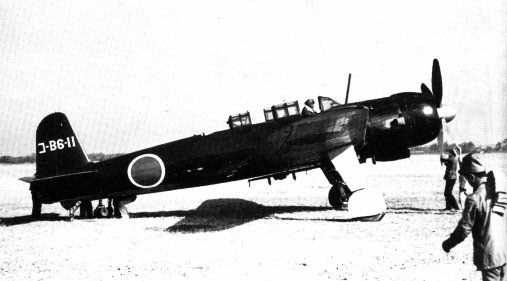
| Historical Information | |||||
| Caption | A mechanic manually turning the engine on a B6N2 torpedo bomber to prevent hydraulic lock, 1940s ww2dbase | ||||
| Date | 1944 | ||||
| Photographer | Unknown | ||||
| Source Information | |||||
| Source | ww2dbaseWikimedia Commons | ||||
| Link to Source | Link | ||||
| Related Content | |||||
| More on... |
| ||||
| Licensing Information | |||||
| Licensing | This work originating in Japan is in the public domain. According to Article 23 of the 1899 Copyright Act of Japan and Article 2 of Supplemental Provisions of Copyright Act of 1970, a work is in the public domain if it was created or published before 1 Jan 1957. Please contact us regarding any inaccuracies with the above information. Thank you. |
||||
| Metadata | |||||
| Added By | C. Peter Chen | ||||
| Photo Size | 507 x 281 pixels | ||||
Você gostou deste artigo ou achou este artigo útil? Se sim, considere nos apoiar no Patreon. Qualquer valor já vai ajudar! Obrigado. Por favor, ajude-nos a divulgar o site: Fique atualizado com WW2DB: |
Visitor Submitted Comments
2.  Bill says:
Bill says:
29 May 2011 08:42:27 PM
KO-B6-11 Nakajima B6N2, Model 12 Tenzen (Jill) was a three-seat torpedo naval bomber.
Operated w/First Naval Air Technical Arsenal
or(Dai-Ichi Kaigun Koku Gijutsusho)aircraft
was used for tests.
1268 "Jills" were built during WWII like most
Japanese aircraft, they were used in Kamikaze
attacks against the US Navy.
One "Jill" survives today this aircraft was on outside display for years, at Willow Grove
NAS, Pa. aircraft has been transferred to the
National Air & Space Museum, Washington D.C.
29 May 2011 08:42:27 PM
KO-B6-11 Nakajima B6N2, Model 12 Tenzen (Jill) was a three-seat torpedo naval bomber.
Operated w/First Naval Air Technical Arsenal
or(Dai-Ichi Kaigun Koku Gijutsusho)aircraft
was used for tests.
1268 "Jills" were built during WWII like most
Japanese aircraft, they were used in Kamikaze
attacks against the US Navy.
One "Jill" survives today this aircraft was on outside display for years, at Willow Grove
NAS, Pa. aircraft has been transferred to the
National Air & Space Museum, Washington D.C.
All visitor submitted comments are opinions of those making the submissions and do not reflect views of WW2DB.
Pesquisar WW2DB

Notícias
- » Wreck of Teruzuki Found (27 jul 2025)
- » USS Orlean's Bow Found (22 jul 2025)
- » The Emperor of Japan Planned to Honor WW2-era Japanese POWs in Mongolia (4 jul 2025)
- » US State Lawmaker John Winter Caught Using Racial Slur "Jap" and Apologized (11 jun 2025)
- » US Government Plans to Purge WW2 Information (17 mar 2025)
- » Ver todas as notícias
Estatísticas Atuais do Site
- » 1,181 biografias
- » 337 eventos
- » 45,111 entradas na linha do tempo
- » 1,247 navios
- » 350 modelos de aeronaves
- » 207 modelos de veículos
- » 376 modelos de armas
- » 123 documentos históricos
- » 261 instalações
- » 470 eventos
- » 28,469 fotos
- » 365 mapas
Citação Famosa da 2ª GM
"The raising of that flag on Suribachi means a Marine Corps for the next 500 years."James Forrestal, Secretary of the Navy, 23 Feb 1945
Apoie-nos
Por favor, considere nos apoiar no Patreon. Mesmo R$1 por mês já faz uma grande diferença. Obrigado!
Ou, por favor, nos apoie adquirindo alguns produtos do WW2DB na TeeSpring. Obrigado!
22 May 2011 11:24:22 AM
SWING THAT PROP:
What is hydraulic lock? In large radial engines oil would collect in the lower cylinders. The propeller had to be swung to clear the oil, otherwise the engine could be damaged or even destroyed, the oil in the bottom cylinders would compress on firing. This also explains the smoke when the engine is fired up.
Ground crews swing the prop by hand before start up and the smoke after starting is caused by oil leaks past the valve guides of the lower cylinders.
COUNTING THE BLADES:
One, Two, Three, Four it ensures that the bottom cylinders are free of oil, and oil can collect in the upside down pistons of a radial engine. Hydrolock, if the start hits a
cylinder full of oil, it just stops, if the engine fires it could blow the cylinderhead off turning the props also opens the exhaust valve and drains the oil.
So counting the blades ensures the engine has turned through one full cycle of each cylinder.
When the ground crew is finished the pilot
switches on starts and Bang, Smoke and Flames
the engine is running there is no other sound in the world like a big radial engine it just says power!
These big radials were designed without any computer adds, just solid engineering, slide rule and calculations.
This is what I remembered about swing the props. it was dangerous but everyone did things by the book.
Photograph of Nakajima B6N2 Tenzan (Heavenly Mountain) Torpedo Bomber the "Jill" could belong to the 752nd or Yokosuka Kokutais.